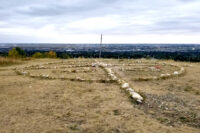Historical buildings an integral part of community, says LHS
By Troy Bannerman - Lethbridge Herald Local Journalism Initiative Reporter on March 3, 2023.
 Herald photo by Troy Bannerman
The Lethbridge Historical Society's Belinda Crowson and Lorien Johanson, in front of the Bowman, say historical buildings are an integral part of the community.
Herald photo by Troy Bannerman
The Lethbridge Historical Society's Belinda Crowson and Lorien Johanson, in front of the Bowman, say historical buildings are an integral part of the community.The loss of two historical buildings in Lethbridge within a month of each other will have a significant impact on the community and many of its residents, says the vice-president of the Lethbridge Historical Society.
Lorien Johansen says many people have emotional ties to the Bow On Tong building and the Lethbridge Hotel, both of which were destroyed by fire on Jan. 31 and Feb. 24 respectively.
“The community impact is so complex,” Johansen says. “With this most recent loss of the Lethbridge Hotel, the pre-eminent thing that I saw on social media of people responding to the images and the story was the loss of a place where they spent a lot of time in their youth.”
Johansen says the hotel, and specifically the bar, hold a lot of memories for many residents, and they will be sad at its loss.
“They are mourning the loss of something that was an integral part of their growing up, formative years.”
Johansen remembers going to that bar when she was 18, and now in her 40s, she has fond memories of those times.
“I’ve always been able to say, ‘hey, I remember going there.’ When we lose that thread that ties all of our generations together it becomes somewhat difficult to maintain the connection between generations and the thread in the tapestry of our community.”
Belinda Crowson, president of the Lethbridge Historical Society, says she hopes the losses of the two buildings will prompt people and governments to learn more about historical buildings, of which there are 2,000 in Lethbridge alone, and urge their designations and protection.
“What I am hoping it will do, is actually inspire people to do work,” Crowson says. “We have a lot of work to do; research them, to write about them, to share the information.
“When the Bow On Tong burned I was inspired and I worked with the Historical Society of Alberta, and we sent off a letter to Minister Luan, the Alberta culture minister, asking for a tripling of the funds that are in the grant pot for historic buildings.”
Crowson says that’s something that should have been done years ago because as more buildings are designated, grants get smaller because the pot of money stays the same, despite an increase in the number of buildings on the designation list.
“What I am hoping is that this will actually encourage people, give them that kick in the butt to actually do something; to ask why we are not looking at these economic drivers of our community, to ask why we are not doing more to protect these buildings provincially, federally.
“We’ve been looking for tax incentives for historic buildings from the federal government since the 1970s. They keep promising, they keep working on it. Nothing gets done! The Americans brought in tax incentives and have been saving historic buildings unbelievably well using that. I hope this actually is the spark that gets behind us. Regret only goes one way. Once we lose these buildings they are gone. We can be sad, or we can actually use it to work. And I am hoping we use it to work.”
Crowson says most of the historically designated buildings in Lethbridge have been repurposed or are in the process of being repurposed for continued use.
“Most of our designated buildings have undergone adaptive reuse and are actually actively being used. And that’s one of the things we work really hard for. When we are looking at designating buildings, the building has to have a purpose, it has to have a use. That’s one of the things I work with the owners on, is making sure there is a use.”
Crowson says out the city’s historic places advisory committee has updated its management plan and will reach out to the public about designation.
“But it starts with the owners,” Crowson adds. “The owners need to be educated. The owners need to understand what is happening, and they need to agree to the designation process.”
Thats one of the reasons the Historical Society started the plaque program a decade and a half ago and began asking building owners if they know how “amazing” their buildings are and how vital they are to the community.
“It’s vital economically, it’s vital environmentally, it’s vital aesthetically, it’s vital historically. There’s something here that you need to understand about your building; it is valuable to the community.”
20-19




